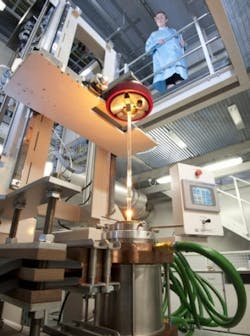Scientists propose coherent amplified fiber-laser network for compact particle accelerators
Southampton, England--An international team of physicists has proposed a coherently combined fiber-laser network to accelerate elementary particles (via wakefield acceleration) to relativistic speeds within a very short distance. The International Coherent Amplification Network (ICAN) project is performing a feasibility study on the proposed laser system, which would be made up of massive arrays of thousands of fiber lasers.1 The accelerator could be used for both fundamental research at laboratories such as CERN (European Organization for Nuclear Research; Geneva, Switzerland) and more-applied tasks such as proton therapy and nuclear transmutation.
Related: Lasers accelerate electrons in three approaches
Related: Lasers accelerate electrons in short order
Petawatt femtosecond lasers can, via wakefield acceleration, produce a relativistic particle beam within a distance of less than a meter, versus at least hundreds of meters for conventional particle accelerators. The resulting compact accelerators would be of great societal importance for applied tasks in medicine, such as making proton therapy for cancer treatment much more accessible, or transmuting elements in dangerous nuclear waste to much safer elements.
Conventional petawatt lasers often produce pulses at a rate of around 1 Hz, whereas for practical applications they would need to operate tens of thousands of times faster. In addition, these petawatt lasers have a low wall-plug efficiency. Because practical applications would require average output powers in the range of tens of kilowatts to megawatts, it is economically not feasible to produce such high levels of power at such low efficiencies.
ICAN consortium
To bridge this technology divide, the ICAN consortium, an EU-funded project initiated and coordinated by the École Polytechnique (Palaiseau, France) and including the University of Southampton's Optoelectronics Research Centre (ORC), CERN, and other labs around the world, aims to replace the conventional single monolithic rod amplifier of a typical petawatt laser with a network of fiber amplifiers and telecommunication-type components.
"One important application demonstrated today has been the possibility to accelerate particles to high energy over very short distances measured in centimeters rather than kilometers as is the case today with conventional technology," says Gérard Mourou of École Polytechnique, who leads the consortium. "This feature is of paramount importance when we know that today high energy physics is limited by the prohibitive size of accelerators, of the size of tens of kilometers, and cost billions of euros. Reducing the size and cost by a large amount is of critical importance for the future of high energy physics."
"A typical CAN laser for high-energy physics may use thousands of fibers, each carrying a small amount of laser energy," says Bill Brocklesby from ORC. "It offers the advantage of relying on well-tested telecommunication elements, such as fiber lasers and other components. The fiber laser offers an excellent efficiency due to laser-diode pumping. It also provides a much larger surface cooling area and therefore makes possible high repetition rate operation. The most stringent difficulty is to phase the lasers within a fraction of a wavelength. This difficulty seemed insurmountable, but a major roadblock has in fact been solved: preliminary proof of concept suggests that thousands of fibers can be controlled to provide a laser output powerful enough to accelerate electrons to energies of several GeV at 10 kHz repetition rate -- an improvement of at least ten thousand times over today's state-of-the-art lasers."
REFERENCE:
1. Gerard Mourou et al., Nature Photonics 7, p. 258 (2013).
About the Author
John Wallace
Senior Technical Editor (1998-2022)
John Wallace was with Laser Focus World for nearly 25 years, retiring in late June 2022. He obtained a bachelor's degree in mechanical engineering and physics at Rutgers University and a master's in optical engineering at the University of Rochester. Before becoming an editor, John worked as an engineer at RCA, Exxon, Eastman Kodak, and GCA Corporation.

